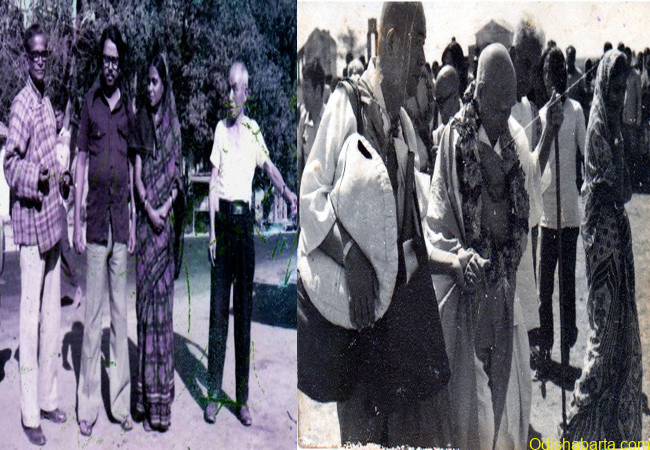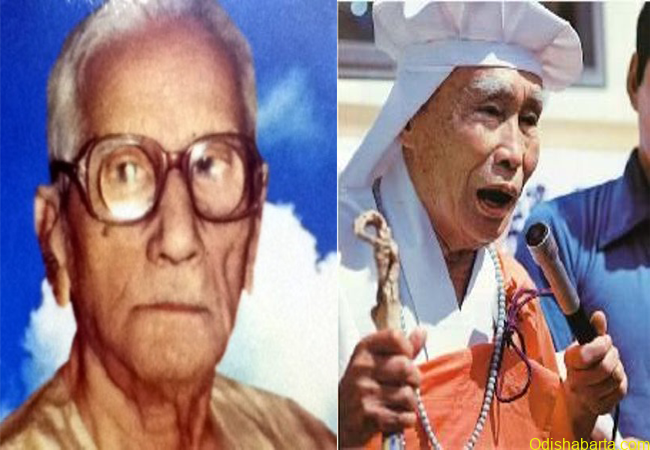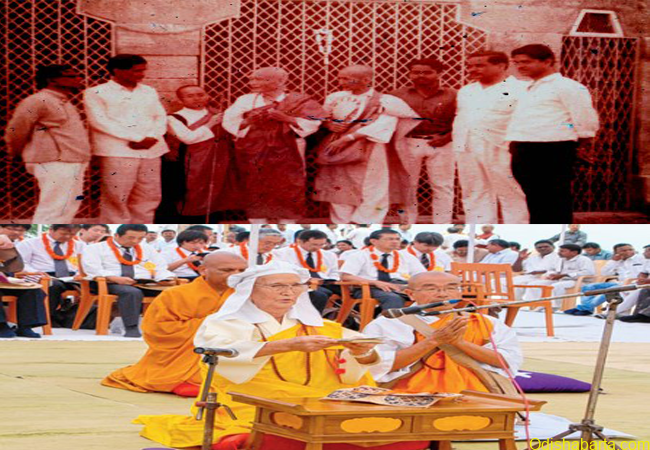DHAULI HILLS HAS MADE SAMRAT ASHOK AND FUJI GURUJI IMMORTAL

By PRASANTA PATNAIK




Dhauli Hillls of Odisha located at a distance of 13 kms from Bhubaneswar was earlier famous for the Ashokan inscriptions and had made Samrat Ashok immortal as he was changed from “ Chandashok” to “Dharmashok’ after witnessing the horrors of the war and miseries of the people , particularly the families of the war victims. The Ashokan inscriptions at Dhauli was famous round the world which was visited by thousands and had made Emperor Ashok Immortal . But because of lack of communication and less publicity it failed to attract more tourists. But the entire scenario changed after Most Venerable Reverend Nichiidastu Fujii, popularly known as Fujii Guruji , President of Japan Buddhan Sangh ( Nipponzan Myohoji )built India’s second Shanti Stupa over the Dhauli Hills.
Fujii Guruji was inspired by two eminenent Odias,, namely Upendra Maharathi and Nityananda Kanungo. Maharathiu was an ardent devotee of Guruji and was the Director of Handicrafts and Industrial Designs, Government of Bihar posted at Patna and Kanungo was the Governor of Bihar. Both Kanungo and Maharathi were very close to each other and convinced Guruji to visit Dhauli Hills which was virtually the turning point in the life of Emperor Ashok to adopt Buddhism .
Finally Guruji agreed to visit Dhauli and Kanungo suggested Maharathi to make necessary arrangements in Bhubaneswar.
Programme for Guruji’s visit was finalised and Maharathi wrote a letter to me mentioning about Gruji’s programme in 1970. During Guruji’s visit to Dhauli Hills, Naharathi ji was present along with me, his nephew Dolagovind Baliarsingh, Prof. Holding a high post in the Ghanasyam Paikray ( His of nephew in law) and Prof, Gouri Kumar Brahma who was holding a high post in the State Tourism Department.
Gruji who was very much upset over the atomic attack on Hiroshima and Nagasaki in Japan was campaigning for establishment of world peace as a decuple of Mahatma Gandhi and had decided to go ahead with construction of peace pagodas all over the world to ensure non-violence and peace,was very much charmed and excited when Dr Brahna narrated him about the Kalinga War which was faught on the bank of river Daya at the foot of Dhauli hills , which virtually forced the great Samrat Ashk to change his mind against violence and to preach the message of peace of Lord Buddha.
After knowing the story of Kalinga War and the change in the hear and mind of Emperor Ashok Guruji then and there announced to build India’s second Shanti Stupa on the top of Dhauli Hills.
Guruji visited again for Bhumi Puja ceremony of the stupa and stayed in a thatched house at the fiit of the hills and looked after the construction of the Prayer Hall , known as Saddhjarma Vihar. During those days it was decided that construction of the Stupa would be taken care of by Kalinga Nippon Buddha Sangh, of which Guruji was the Chief Patron along with Nityananda Kanungo ji as the President, Upendra Maharathi as Secetary and Treasurer and Samaj editor Radhanatha Rath as the Vice President Vikhyu Shanti Sugei was the Joint Secretary.
Letters were written to the Chief Minister to provide road , water and power connection to the stupa site. I was assigned the job of Liaison Officer to coordinate with the State Government. At that time Md. Mumtaz Ali was the Chief Engineer P.W,D, and Khitish Patnaik Was the S.D.O., S.N. Joshi was the Superintendent Engineer of P,H.D. ( Water ) .
Dayanidhi Patnaik, a senior O.A.S. officer was the Tahasildar, Khurdha who was looking after land matters, while S.M.Patnaik, ecretary, Revenue Department was at the helm of affairs.
The design for the Shanti Stupa at Dhauli was drawn by Dr, Minoru Ooka,, professor and Head of Department of Tokyo University, along with a master plan for development of the foot hills. Maharathji was also associated with the planning which was approved by Guruji.
To look after the Japanese monks engaged in construction work and to pursue at the Government level I had to shuttle between Bhubaneswar and Dhauli very frequently in my scooter along with my wife Chandraprava who was considered as a sister to most of the Japanese monks. Guruji had fixed up to inaugurate the Stupa on 8th November, 1972.
It has four massive idols of Lord Buddha in different postures along with Gautam Buddha’s life. These are all carved on stone slabs. It has various rock edicts, which are a living testimony of emperor Ashoka’s transformation.
Historians say Ashoka wrote ‘welfare of the whole world’ which depicts his concern about humanity. A rock-cut elephant above the edicts is one of the oldest Buddhist sculptures in Odisha.
The beautiful dazzling white DhauliGiri Shanti Stupa is a dome-shaped structure that is embellished with fascinating stone panels which are eye-catching and can hold one’s attention. There are some amazing stone carvings of Lord Buddha in different postures along with a relaxing posture. His footprints, Dharma chakra were used as decoration in Buddhist temples, statues, and inscriptions from the earliest period of Indian Buddhism. The Bodhi tree is a large and sacred fig tree. Some stone panels are inscribed with the scenes when Emperor Ashoka was offering his sword to Lord Buddha and resigning from the war, an elephant and horseback procession, and various Buddhist anthems.
He transferred his energy, which he used to spend in winning wars and fighting, to spiritual activity. He became a Buddhist and a follower of Buddha’s teachings and started living a sober, solemn, simple and life without any luxury.
He also thought about the practicality of wars which only brings destruction and death and misery to humanity. Due to this thought, the Great Warrior became a follower of Buddhism and spent his whole life spreading the teachings of Buddha first in Odisha then all around the world.
Carvings of an elephant emerging from the rock are the mark where the transformation of the heart and thoughts of Ashoka took place. It is the oldest rock-cut sculpture in India around the 3rd The narrative history is carved by king Ashoka on the cliff rock, onto the pillars and caves throughout India. It suggests that the ruling area may have had two administrative headquarters. There were instructions carved on the stones addressing his administrators which was about how to rule his subjects. Which are something like this —“ Your motive should be to gain the affection of humanity. All humans are our children, and as I always want my children to obtain welfare and happiness both in this world and the other world side of the world, the same I should desire for all …”
These edicts showed the remarkable transformation of a Great merciless and heatless warrior king to a kind and warm-hearted soul who dedicated his life to the Buddhist way of living that was enlightened and harsh to live for a Great warrior. These inscriptions were clearly visible even after 2000 years.
Thus Dhauli Hills have made Samrat Ashok and Fujii Guruji immortal . No one would forget their names till the rock edicts and the Shanti Stupa exists. Contributions of persons like Nityananda Kanungo and Upendra Maharathi in convincing Fuji Guruji to visit Dhauli and motivating him for construction of Shanti Stupa on the top of Dhauli Hills should also not be forgotten by us who feel proud of this monument built half a century ago.





